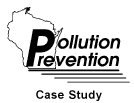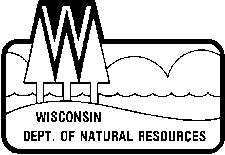
|
Grand Chute
Menasha West
Sewerage Commission
Ultraviolet Disinfection
System |
| Standard Industrial Classification
(SIC) |
Sewerage System/4952 |
| Type of Waste |
Residual chlorine in wastewater effluent |
| Strategy |
Process/equipment modification |
| Company Background |
The Grand Chute Menasha West Sewerage
Commission (GCMWSC) was established in 1981. The wastewater treatment facility was built
in 1983 and provides sewage treatment services for the towns of Grand Chute, Menasha, and
Greenville. The facility operates with nine full-time employees. |
| Original Process |
Seasonal fecal coliform limits on the
wastewater effluent require disinfection of the wastewater. Disinfection was accomplished
by adding chlorine prior to discharge. It was anticipated that future permits would also
require dechlorination of the wastewater prior to discharge. Expansion of existing
facilities would have been necessary along with additional chemical feed to accomplish
dechlorination. |
| Motivation |
The main motivation for selecting a new
disinfection process was to enhance public safety by eliminating the source of potential
accidental releases of chlorine gas. GCMWSC needed to anticipate future permit
requirements and was motivated to keep chlorine out of the Fox River to limit
environmental liability. |
| Pollution Prevention Process |
The wastewater effluent is directed into
channels that contain ultraviolet (UV) lamps. These lamps emit UV wavelengths that
disinfect by destroying fecal coliform bacteria and other harmful organisms. This process
treats a maximum design flow of 16.4 million gallons/day and effectively meets or exceeds
permit limits without the addition of any chemicals to the secondary effluent. |
| Stage of Development |
The UV disinfection system has been in use
since July of 1993. |
| Level of Commercialization |
UV disinfection of wastewater effluent was
developed for tertiary effluents but not secondary effluents. Pilot testing was done to
demonstrate feasibility to treat a secondary effluent and to address maintenance concerns
for this facility. |
| Obstacles |
Information to operate a UV disinfection
system was not readily available. Employees engaged a "trial-and-error" approach
to run the process effectively. |
| Material/Energy Balance |
| |
Description |
Expanded Chlorine
Disinfection |
UV
Disinfection |
| Feedstock |
chlorine for disinfection |
313 lbs/day |
0 |
| Energy |
electricity |
1,283 KWH/yr. |
69,120 KWH/yr. |
| Waste/Disposal |
SO2 for dechlorination
of effluent |
196 lbs/day |
0 |
|
| Economics |
| Capital Costs |
Description |
Cost/Benefit |
| Equipment cost |
1) UV disinfection system 2) chlorine/dechlorination |
$900,000
($750,000) |
| Space needs (saving) |
additional chlorine contact tank needed |
($25,000) |
| |
Total |
$225,000 |
The costs for upgrading the disinfection system were compared to
evaluate a net capital cost.
Operating Costs |
Description |
Cost
Old Process |
Cost
New Process |
Cost/Savings |
| Raw Materials/supplies |
1) chemicals 2) lamps |
$50,000 0 |
$1,000 $5,000 |
$44,000 |
| Labor (process operation; time spent
ordering/receiving supplies) |
|
$20,000 |
$20,000 |
0 |
| Maintenance (both labor and materials) |
|
$5,000 |
$5,000 |
0 |
| On-going safety and equipment training |
|
$5,000 |
$1,000 |
$4,000 |
| Annual Permits |
|
$6,000 |
0 |
$6,000 |
| Paperwork |
|
$3,000 |
$500 |
$2,500 |
| Utilities |
electricity |
$1,000 |
$10,000 |
($9,000) |
| |
|
|
Total Cost Savings/Year |
$47,500 |
Payback Period
In comparing the cost of upgrading the original chlorine disinfection
system versus selecting the new ultraviolet disinfection system, GCMWSC can expect to
recover the cost difference of this process in a little under 5 years. |
| Benefits |
Benefits include: decreased environmental
and financial liability, elimination of chemical use, ease of meeting permit requirements,
elimination of reporting requirements, and elimination of the need for an evacuation plan. |
| Technology Transfer |
The technologies applied at GCMWSC are
currently available and can be applied elsewhere. |
| Company Address |
Grand Chute Menasha West Sewerage
Commission
1965 W. Butte Des Morts Beach Road
Neenah, Wisconsin 54956 |
| Contact Person |
James R. Kirk, Plant Superintendent
(414) 739-7921 |
| Waste Reduction Resources |
Department of Natural Resources
Northeast Region
Carol Schmidt, 414/492-5871Free, On-site Technical Assistance
University of Wisconsin Extension
Solid and Hazardous Waste Education Center
Milwaukee area: 414/475-2845
Remainder of state: 608/262-0385
Pollution Prevention Information Clearinghouse
Wisconsin Department of Natural Resources
Hazardous Waste Minimization Program
608/264-8852, 608/267-9523 or 608/267-3763 |
 |
Bureau of Cooperative Environmental Assistance
Wisconsin Department of Natural Resources
P.O. Box 7921
Madison, WI 53707
608/267-9700
PUBL CO-053 96 |
|

